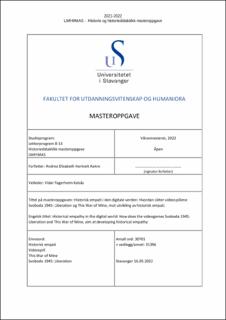| dc.contributor.advisor | Kalsås, Vidar Fagerheim | |
| dc.contributor.author | Aakre, Andrea Elisabeth Hartveit | |
| dc.date.accessioned | 2022-07-01T15:51:30Z | |
| dc.date.available | 2022-07-01T15:51:30Z | |
| dc.date.issued | 2022 | |
| dc.identifier | no.uis:inspera:110337907:23117106 | |
| dc.identifier.uri | https://hdl.handle.net/11250/3002105 | |
| dc.description.abstract | I 2020 ble historisk empati en del av den nye læreplanen. Historisk empati er et begrep som
forskere har hatt vanskeligheter med å definere. Dette gjør også at det har vært problematisk å
vite hvordan lærere kan inkorporere historisk empati i sin undervisning. Videospill er også en
undervisningsmetode som blitt populær på skolene. Noen forskere mener at videospill kan
være en god undervisningsmetode i historisk empati. Denne avhandlingen har undersøkt
«hvordan videospillene Svoboda 1945 og This War of Mine sikter mot utvikling av historisk
empati».
For å analysere de to videospillene i lys av historisk empati har jeg brukt teoriene til Barton
og Levstik. Deres teorier viser til at historisk empati har to dimensjoner. Den kognitive
(perspektivanerkjennelse) og den affektive («care» begrepet).
Analysene viser at Svoboda 1945 er et spill som i stor grad krysser av de på fleste
kategoriene. Derfor kan videospillet, i teorien, bruker til historisk empati. This War of Mine
krysser ikke av på like mange av kategoriene. En spiller vil derfor mest sannsynlig kun
utvikle empati, ikke historisk empati. Allikevel er det mulig å bruke videospillene i
undervisning hvis læreren fyller de hullene som spillene mangler i historisk empati.
Resultatet viser at av de to videospillene så er det Svoboda 1945 som gir en spiller større
sjanse for å utvikle historisk empati ifølge teorien, mens This War of Mine bare gir spilleren
en delvis sjanse for å utvikle historisk empati. | |
| dc.description.abstract | In 2020, historical empathy became part of the new curriculum. Historical empathy is a term
that researchers have had difficulty defining. This also makes it problematic to know how
teachers can incorporate historical empathy into their teaching. Video games are also a
teaching method that has become popular in schools. Some researchers believe that video
games can be a good teaching method in historical empathy. This dissertation has examined
"how the video games Svoboda 1945 and This War of Mine aim at the development of
historical empathy".
To analyze the two video games in the light of historical empathy, I have used the theories of
Barton and Levstik. Their theories point out that historical empathy has two dimensions. The
cognitive (perspective recognition) and the affective ("care" concept).
The analyses show that Svoboda 1945 is a game that largely checks most categories in
historical empathy. Therefore, the video game can, in theory, be used for historical empathy.
This War of Mine does not check off as many of the categories. A player will therefore, most
likely, only develop empathy, not historical empathy. Nevertheless, it is possible to use the
video games in teaching if the teacher fills the gaps that the games lack in historical empathy.
The result shows that of the two video games, it is Svoboda 1945 that gives a player a greater
chance of developing historical empathy according to the theory, while This War of Mine
only gives the player a partial chance to develop historical empathy | |
| dc.language | nob | |
| dc.publisher | uis | |
| dc.title | Historisk empati i den digitale verden: Hvordan sikter videospillene
Svoboda 1945: Liberation og This War of Mine, mot utvikling av historisk empati. | |
| dc.type | Master thesis | |
